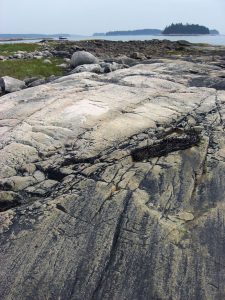
The northern coast of Maine is filled with elongated lakes and ponds, rounded mountains and large stretches of bare granite. All are relics of a not-so-distant past when Maine was covered by huge continental glaciers during the Pleistocene Epoch, or “The Ice Ages,” which started some 2.5 million years ago. Immense glaciers of ice and snow ebbed and flowed across the landscape and did not begin their final melting and retreat until just 18,000 to 11,000 years ago.
Glacial Erratics

Here and there on the landscape and around so-called glacial ponds, you’ll spot huge boulders that seem out of place. How did they get there? These are known as glacial erratics, or large boulders, that were once swept up and incorporated into the ice sheets. When those sheets melted, they left behind loads of gravel, sand, silt—and huge boulders, some as long as 100 feet and 8,000 tons in weight. But such boulders did more than simply drop from the ice when it finally melted.
Glacial Striations
Wherever you find stretches of flat, bald granite in Maine, it seems you also find etched grooves parallel to one another on the surface of that granite. These linear grooves were carved by those aforementioned boulders along with gravel and sand. Caught within the ice, they moved with the massive glaciers that towered thousands of feet above them and produced intense pressure. The pressure and movement as the glaciers inched along created great friction that combined with the boulders, gravel and sand to abrade the granite below and carve those grooves, called glacial striations.

In addition to telling us that glaciers once dominated the Downeast landscape, glacial striations have been used by scientists to infer directions of movement by the glaciers and, thereby, to help pinpoint where such glaciers originated. The erratics also help in this inference. A big boulder that doesn’t seem native to a particular area might be traced back to spots from which the glaciers first plucked it up. Thus, glacial erratics and striations combine to help us “read” the history of a particular landscape and provide a vivid retelling of its past.
This story about glacial erratics and glacial striations appeared in Rock & Gem magazine. Click here to subscribe. Story by Jim Brace-Thompson.












